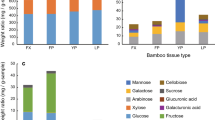Abstract
Carbohydrate concentrations in the marginal hypothallus and areolae of the crustose lichen Rhizocarpon geographicum (L.) DC. were measured in north Wales, U.K. using gas chromatography. Ribitol, arabitol, and mannitol were the most abundant carbohydrates while α- glucose β-glucose, fructose, sucrose, and trehalose were present in smaller amounts. The concentrations of arabitol, ribitol, mannitol, fructose, and α-glucose were greater in the areolae while the concentration of trehalose was greater in the hypothallus. Concentrations of carbohydrates varied little between sample days. Concentrations of polyols in the hypothallus were not correlated with those in the areolae. These results suggest: 1) the hypothallus has a lower demand for carbohydrates than the areolae or there is limited transport from areolae to hypothallus, 2) increased trehalose in the non-lichenised hypothallus may be an adaptation to withstand stress and desiccation, and 3) polyols are partitioned differently in the hypothallus and areolae.
Similar content being viewed by others
References
Armstrong RA (1974) The descriptive ecology of saxicolous lichens in an area of South Merionethshire, Wales. Journal of Ecology 62:33–45
Armstrong RA (1982) Growth curve of the lichen Rhizocarpon geographicum. New Phytologist 94:619–622
Armstrong RA (2002) The effect of rock surface aspect on growth, size structure and competition in the lichen Rhizocarpon geographicum. Environmental and Experimental Botany 48:187–194
Armstrong RA (2004) Lichens, lichenometry and global warming. Microbiologist 5:32–35
Armstrong RA (2005) Radial growth of Rhizocarpon section Rhizocarpon lichen thalli over six years at Snoqualmie Pass in the Cascade Range, Washington State. Arctic, Antarctic, and Alpine Research 37:411–415
Armstrong RA, Bradwell T (2001) Variation in hypothallus width and the growth of the lichen Rhizocarpon geographicum (L.) DC. Symbiosis 30:317–328
Armstrong RA, Smith SN (1987) Development and growth of the lichen Rhizocarpon geographicum. Symbiosis 3:287–300
Armstrong RA, Smith SN (1994) The levels of ribitol, arabitol, and mannitol in individual lobes of the lichen Parmelia conspersa (Ehrh. ex Ach.) Ach. Environmental and Experimental Botany 34:253–260
Armstrong RA, Smith SN (1996) Do the lichens Xanthoparmelia conspersa (Ach.) Hale and Rhizocarpon Ram. em Th. Fr. Subgenus Rhizocarpon utilize exogenous carbohydrates for radial growth? Environmental and Experimental Botany 36:13–20
Avonce N, Mendoza-Vargas A, Morett E, Iturriaga G (2006) Insights on the evolution of trehalose biosynthesis. BioMed Central Evolutionary Biology 6:109–124
Benedict JB (1988) Techniques in lichenometry: identifying the yellow rhizocarpons. Arctic and Alpine Research 22:244–254
Bradwell T, Armstrong RA (2007) Growth rates of Rhizocarpon geographicum lichens: a review with new data from Ireland. Journal of Quaternary Science 22:311–320
Chapman BE, Roser DJ, Seppelt RD (1994) C-13NMR analysis of Antarctic cryptogam extracts. Antarctic Science 6:295–305
Clayden SR (1998) Thallus initiation and development in the lichen Rhizocarpon lecanorinum. New Phytologist 139:685–695
Farrar JF (1973) Lichen physiology: Progress and pitfalls. In: Ferry BW, Baddeley MS, Hawksworth DL (eds) Air Pollution and Lichens. Athlone Press, University of London, London, pp 238–282
Farrar JF, Smith DC (1976) Ecological physiology of the lichen Hypogymnia physodes III. The importance of the rewetting phase. New Phytologist 77:115–125
Honegger R, Kutasi V, Ruffner HP (1993) Polyol patterns in 11 species of aposymbiotically cultured lichen mycobionts. Mycological Research 97:35–39
Honegger R (1998) The lichen symbiosis: What is spectacular about it? Lichenologist 30:193–212
Holligan M (1971) Routine analysis by gas-liquid chromatography of soluble carbohydrates in extracts of plant tissue. I. A review of techniques used for the separation, identification, and estimation of carbohydrates by gas-liquid chromatography. New Phytologist 70:239–269
Holligan M, Drew EA (1971) Routine analysis by gas-liquid chromatography of soluble carbohydrates in extracts of plant tissue. II. Quantitative analysis of standard carbohydrates and separation and estimation of soluble sugars and polyols from a variety of plant tissues. New Phytologist 70:271–297
Innes JL (1985) Lichenometry. Progress in Physical Geography 9:187–154
James PW, Hawksworth DL, Rose F (1977) Lichen communities in the British Isles: A preliminary conspectus. In: Seaward MRD (ed) Lichen Ecology. Academic Press, New York, pp 295–419
Lewis DH, Smith DC (1967) Sugar alcohols (polyols) in fungi and green plants. I. Distribution, physiology and metabolism. New Phytologist 66:143–184
Melick DR, Seppelt RD (1994) Seasonal investigations of soluble carbohydrates and pigment levels in Antarctic bryophytes and lichens. Bryologist 97:13–19
Montiel PO (2000) Soluble carbohydrates (trehalose in particular) and cryoprotection in polar biota. Cryo-Letters 21:83–90
Nienburg W (1926) Anatomie der Flechten. In: Linstauer K (ed) Handbuch der Pflanzenanatomie, vol 6. Borntraeger, Berlin, pp 1–137
Poelt J (1988) Rhizocarpon Ram. em. Th. Fr. subgenus Rhizocarpon in Europe. Arctic and Alpine Research 20:292–298
Purvis OW, Coppins BJ, Hawksworth DL, James PW, Moore DM (1992) The Lichen Flora of Great Britain and Ireland. Natural History Museum Publication, London
Richardson DHS, Hill DJ, Smith DC (1968) Lichen physiology XI. The role of the alga in determining the pattern of carbohydrate movement between lichen symbionts. New Phytologist 67:469–486
Sola-Penna M, Meyer Fernandes JR (1998) Stabilization against thermal inactivation promoted by sugars on enzyme structure and function: Why is trehalose more effective than other sugars? Archives of Biochemistry and Biophysics 360:10–14
Vicente C, Mateus JL, Pedrosa MM, Legaz ME (1991) High performance liquid-chromatographic determination of sugars and alcohols in extracts of lichens and sugarcane juice. Journal of Chromatography 553:1–2
Whipps J, Cooke RC (1978) Comparative physiology of Albugo tragopogonis-infected and Puccinia laganophoraeinfected plants of Senecio squalidus L. New Phytologist 81:307–319
Author information
Authors and Affiliations
Corresponding author
Rights and permissions
About this article
Cite this article
Armstrong, R., Smith, S. Carbohydrates in the hypothallus and areolae of the crustose lichen Rhizocarpon geographicum (L.) DC.. Symbiosis 49, 95–100 (2009). https://doi.org/10.1007/s13199-009-0016-z
Received:
Accepted:
Published:
Issue Date:
DOI: https://doi.org/10.1007/s13199-009-0016-z




